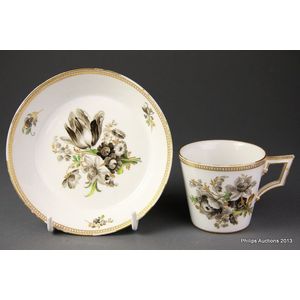Meissen Cup and Saucer with Flower Sprigs and Grisaille Bouquets
You must be a subscriber, and be logged in to view price and dealer details.
Subscribe Now to view actual auction price for this item
When you subscribe, you have the option of setting the currency in which to display prices to $Au, $US, $NZ or Stg.
- Grisaille - Decorative painting in monochrome, usually shades of grey, olive green or buff, painted on wood, plaster, ceramic or stone surfaces to imitate marble figural sculpture or relief ornament.Grisaille, from the French "gris", or grey (colour) is a painting technique in which a monochrome image is created using only shades of gray, black and white, usually created by using a gray underpainting or a limited colour palette. It is often used to create the illusion of sculpture or relief on a flat surface, and was commonly used during the Renaissance and Baroque periods.
The technique of grisaille has been used in decorative arts for centuries. It was commonly used in the Renaissance and Baroque periods in Europe to create the illusion of sculptural relief on flat surfaces such as walls, ceilings, and furniture. This technique allowed artists to create the illusion of depth and dimensionality without the use of colour.
During the Rococo period, grisaille was often used in the production of ceramics and porcelain to create finely detailed designs on a white or light-colored surface.
In the 19th century, grisaille continued to be used in decorative arts, particularly in the production of ceramics, both Western and Oriental. - Circa - A Latin term meaning 'about', often used in the antique trade to give an approximate date for the piece, usually considered to be five years on either side of the circa year. Thus, circa 1900 means the piece was made about 1900, probably between 1895 and 1905. The expression is sometimes abbreviated to c.1900.
This item has been included into following indexes:
Visually similar items

A Miles Mason cup and saucer, circa 1805, the cup in Hamilton flute shape with the characteristic ring handle, both decorated with apricot borders and gilt vegetal motifs between gold bands, a gilt spray to the centre of the saucer; unmarked, height 6.5 cm

A delightful and rare Worcester tea cup and saucer, circa 1765-70, in the Chinoiserie 'Red bull' pattern, printed and decorated in the mandarin palette with bulls and figures in a landscape setting. Provenance: with a label underside for Havelock house Ant

19th century Royal Worcester floral trio

A Dr Wall Worcester 'Chinese Family' tea bowl and saucer, circa 1770, a delightful petite bowl and conforming saucer with crow's foot red and gold borders and decorated in a polychrome palette with narrative scenes comprising pairs of male and female figur
